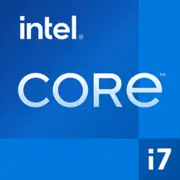Intel Core i7-9800X X-series

Intel Core i7-9800X X-Series: Overview and Practical Recommendations for 2025
(Relevant as of April 2025)
1. Key Specifications: Architecture and Performance
Architecture and Manufacturing Process
The Intel Core i7-9800X processor belongs to the X-Series lineup, built on the Skylake-X microarchitecture (14nm). Although the 14nm manufacturing process is considered outdated by 2025, Intel maintains it in the HEDT (High-End Desktop) segment for a balance between cost and performance. Key features include:
- 8 cores / 16 threads with a base frequency of 3.8 GHz and a turbo boost up to 4.5 GHz.
- Support for 64 PCIe 3.0 lanes (relevant for multi-drive systems and multiple GPUs).
- Technologies such as Hyper-Threading, Turbo Boost Max 3.0, AVX-512 for workloads.
Performance
According to Geekbench 6 (2025):
- Single-Core: 1359 — a level sufficient for most games and applications focused on single-core speed.
- Multi-Core: 7090 — a strong result for rendering, 3D modeling, and code compilation.
Key Features
- Unlocked multiplier for overclocking (even with a TDP of 165W).
- Support for Optane Memory to accelerate storage solutions.
2. Compatible Motherboards
Socket and Chipsets
The processor uses the LGA 2066 (Socket R4). Recommended chipsets include:
- Intel X299 — the only option for fully unlocking the processor's potential (price of new boards: $250–$400).
Examples of models: ASUS ROG Rampage VI Extreme, MSI X299 SLI Plus.
Selection Features
- VRM module: Look for boards with 8+ power phases for stable overclocking.
- Cooling: Due to the TDP of 165W, having heatsinks on the VRM and M.2 slots is critical.
- Compatibility: Some X299 boards require a BIOS update to work with the i7-9800X.
3. Supported Memory
Types and Configurations
The processor supports DDR4-2666 MHz (maximum of 128GB in quad-channel mode). By 2025, DDR4 lags behind DDR5 in bandwidth but remains cheaper (16GB DDR4 — $50 vs. DDR5 — $80).
Recommendations
- For multi-threaded tasks, use quad-channel kits (e.g., 4x8GB).
- Latency of CL16–CL18 is the optimal choice for a balance of price and speed.
4. Power Supply: Power Calculation
Minimum Requirements
With a TDP of 165W and a high-end graphics card installed (e.g., NVIDIA RTX 4070 Ti):
- Power Supply of at least 750W (80+ Gold or higher).
- Examples of models: Corsair RM750x ($130), Seasonic Focus GX-750 ($140).
Features
- Avoid cheap power supplies without certification — there is a high risk of voltage drops.
- For overclocking, allow an extra 100–150W (e.g., 850W).
5. Pros and Cons
Advantages
- Multi-threaded performance: 16 threads excel at rendering and virtualization.
- Configuration flexibility: 64 PCIe 3.0 lanes for multiple GPUs or NVMe drives.
- Price: In 2025, the processor is sold for $320–$380 (new), which is cheaper than AMD counterparts like the Ryzen 9 7900X ($450).
Disadvantages
- High power consumption: 165W compared to 105W for Ryzen 7 7800X.
- Outdated manufacturing process: 14nm vs. 5nm for competitors (greater heat, lower efficiency).
- No DDR5 or PCIe 5.0: Limitations for future upgrades.
6. Use Case Scenarios
Gaming
- At Full HD / 1440p with RTX 4070: 90–120 FPS in AAA titles (Cyberpunk 2077, Starfield).
- Downside: In games dependent on single-core speed, it lags behind the Ryzen 7 7800X3D (+15% in fps).
Work Tasks
- Blender, Adobe Premiere: Rendering speeds are 8-20% faster than the Core i7-12700K.
- Virtualization: 16 threads allow multiple OS instances to run smoothly.
Multimedia
- Streaming (OBS + gaming) — stable performance thanks to 8 cores.
7. Comparison with Competitors
AMD Ryzen 7 7800X ($400)
- Pros: 5nm, DDR5, PCIe 5.0, energy efficiency.
- Cons: 8 cores / 16 threads, but 10–15% faster in gaming.
Intel Core i9-9900X ($450)
- Pros: 10 cores, higher multi-core score (Geekbench 6 ~8500).
- Cons: Price and TDP of 180W.
Conclusion: The i7-9800X is advantageous for budget workstations where price per core is critical.
8. Practical Assembly Tips
- Cooling: High-end coolers like Noctua NH-D15 ($110) or Corsair iCUE H150i ($170).
- Case: At least 2 intake fans (example: Fractal Design Meshify 2).
- Storage: 1–2 NVMe SSDs (e.g., Samsung 990 Pro 1TB — $120) + SATA SSD for archives.
9. Final Conclusion: Who Should Choose the i7-9800X?
This processor is worth considering if:
1. You need a workstation for rendering without overpaying for "extreme" cores.
2. You are planning an upgrade from previous LGA 2066 generations (saving on motherboard replacement).
3. Overclocking is important on a relatively affordable platform.
However, if you're building a future-proof PC with DDR5 and PCIe 5.0 — look towards Ryzen 7000 or Intel Alder Lake-X.
Prices are relevant as of April 2025. Check availability and configurations with official suppliers before purchase.
Basic
CPU Specifications
Memory Specifications
Miscellaneous
Benchmarks
Compared to Other CPU
Share in social media
Or Link To Us
<a href="https://cputronic.com/cpu/intel-core-i7-9800x-x-series" target="_blank">Intel Core i7-9800X X-series</a>